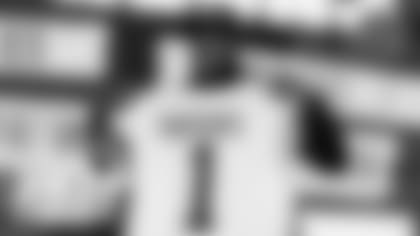FRISCO, Texas – All's well that ends well, it would seem.
No two drafts play out the same way, and the best-laid plans often never come to fruition. If anyone ever wanted evidence, these last two draft classes prove the point.
One year ago, it seemed the Cowboys could not have drawn things up better. One of the draft's best players, CeeDee Lamb, fell to them all the way at pick No. 17. Roughly 24 hours later, they spent the 51st pick on a guy they might have considered in the first round in cornerback Trevon Diggs.
If 2020 was a rare best-case scenario, 2021 felt like a lesson in adapting. That was made obvious from the very beginning, when the team's biggest need in the draft – cornerback – was wiped out with consecutive picks in front of them.
Even if that development wasn't preferred, though, it was always seen as a possibility. And when the duo of Jaycee Horn and Patrick Surtain II went off the board, the Cowboys had the wherewithal to not just trade back to No. 12 overall, but still identify their preferred remaining target in Micah Parsons.
"We had long discussions about, 'If the corners go, what are we going to do here,'" said Cowboys chief operating officer Stephen Jones on Monday. "And that's where we spent a lot of time on Micah – not to mention a couple other players we could be real comfortable with if the two corners went. Which, obviously that happened."
Added executive vice president of player personnel Will McClay on Saturday night: "Micah Parsons being there when the corners left was a big thing that we all looked at each other and said 'There is a difference maker.'"
The first round is only one aspect of a draft class, though. Throughout the weekend, the Cowboys seemed to walk the tight rope between "want" and "need." The coming years will prove how well they walked that line, but it's something they seemed to acknowledge having to do.
Nowhere was that more evident than during an unpredictably Day 2, when the front office made three selections that threw outsiders for a loop.
Having secured their coveted cornerback in the second round, the front office turned toward the defensive line with its 75th and 84th picks, selecting UCLA defensive tackle Osa Odighizua and Iowa defensive end Chauncey Golston.
The final pick of the night, No. 99 overall, was perhaps the most interesting of the entire draft. With the selection of Nahshan Wright, the Cowboys landed a 6'4 cornerback they clearly coveted – but who was not on the radar of many fans or analysts.
"I think it was long overdue that the board fall right and that we were able to pick the defensive guys," said Stephen Jones.
This was the most interesting part of the whole process, however. Saturday evening, after Day 3 had seen them draft coveted linebacker prospect Jabril Cox – in addition to five others – Cowboys owner/general manager Jerry Jones again mentioned the balancing act.
"It was real interesting that I saw that Wright was a little high. But you go on down the road and Cox is a little low," he said. "It averages out when you're sitting there staying with your board."
That's a reality of the NFL draft that rarely gets acknowledged. Teams regularly make decisions outside the parameters of grades – whether it be positional value, scheme fit or outright need. Even still, it's fascinating to hear the front office expound on the thought process.
To hear it from Jones, the Cowboys had multiple options they felt good about during that run of mid-round picks. Regardless of the individual grades, they felt good to come away from this draft with the majority of them.
"We had six or seven players that, when we made the Wright pick, that we were debating whether to pick that player or to pick that player," he said. "What ended up happening is we ended up getting four of the six that we were talking about at that time."
The end result is a draft class with eight of 11 selections coming on the defensive side of the ball – an obvious attempt to upgrade a unit that was among the worst in the NFL last year. And while Parsons and Joseph may be the only rookies who push for a starting job, it's clear the Cowboys have roles in mind for a lot of them.
From the outsider's perspective, the method felt less obvious in 2021 than it did a year ago. But the bottom line is the same from outside the war room as it is from inside: if the Cowboys are right about their evaluations, it'll work out just fine.














